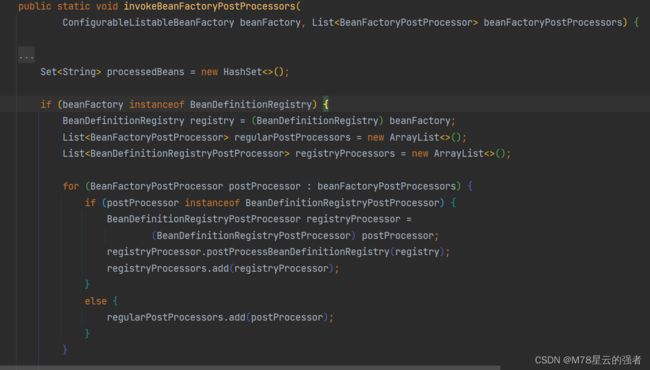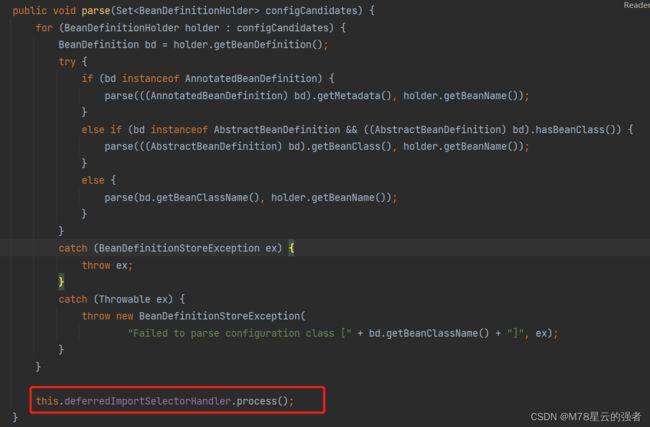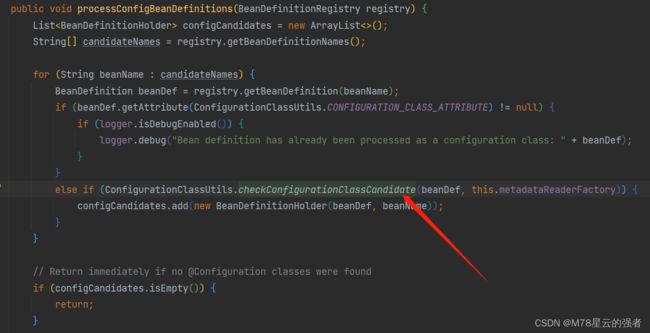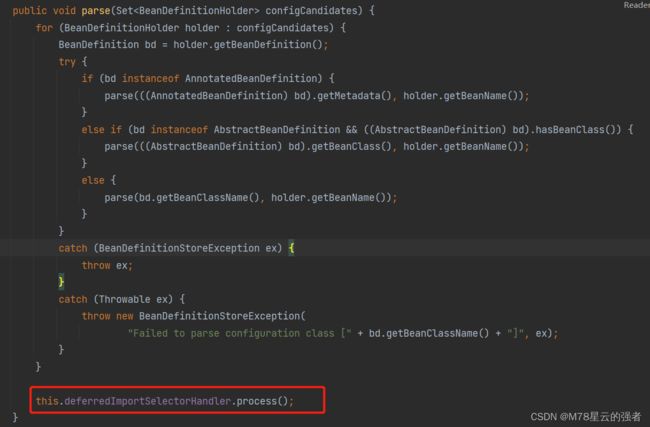SpringBoot自动装配详解
一.前言
本文是作者阅读Spring源码的记录文章,由于本人技术水平有限,在文章中难免出现错误,如有发现,感谢各位指正。
在学习过程中也看过很多springboot自动装配的文章,但是大多仅停留在注解的解释上,并不能全面的讲述spring在自动装配过程中的工作过程。作者在学习spring源码的过程中看到了相关的代码,就产出了本文章。
二.一切的开始SpringBoot启动类
一个简单的启动类,main方法中把当前启动类传入作为参数。
@SpringBootApplication
public class DesignApplication {
public static void main(String[] args) throws Exception {
SpringApplication.run(DesignApplication.class, args);
}
}下面就是老生常谈的@SpringBootApplication介绍,如果已经熟悉这部分的内容可以直接跳转第三节内容。
启动类只是一个简单的java类,只不过类上面被@SpringBootApplication注释。
@SpringBootConfiguration
@EnableAutoConfiguration
@ComponentScan其中第一个注解@SpringBootConfiguration是对@Configuration的封装,作为一个FULL(后面会讲)类型的配置类被spring容器管理、解析、代理。
第三个注解@ComponentScan是大家比较熟悉的注解了,用于组件扫描,扫描的范围是启动类的同路径及子路径。
第二个注解就是比较重要的注解了@EnableAutoConfiguration,先说个题外话,想必大家在使用SpringBoot的过程中遇到过很多以Enable开头的注解,比如@EnableAspectJAutoProxy开启自动代理的注解,(在我看过的注解中)这些注解的解析方式大都类似,大家可以看过作者这篇文章自己去看下自动代理的注解解析实现。
回到咱们的@EnableAutoConfiguration,其主要实现如下:
@AutoConfigurationPackage
@Import({AutoConfigurationImportSelector.class})其中咱们比较熟悉的就是这个@Import注解,见名知义,导入一个类AutoConfigurationImportSelector.class。其实现如下:
public class AutoConfigurationImportSelector implements DeferredImportSelector, BeanClassLoaderAware, ResourceLoaderAware, BeanFactoryAware, EnvironmentAware, Ordered 它实现了DeferrImportSelector接口,这个接口不用仔细看,只要知道接口名称DeferredImportSelector、内部接口名称group、与其中一个方法selectImports(),在此接口实现如下:
public interface DeferredImportSelector extends ImportSelector {
/**
* Return a specific import group.
* The default implementations return {@code null} for no grouping required.
* @return the import group class, or {@code null} if none
* @since 5.0
*/
@Nullable
default Class getImportGroup() {
return null;
}
/**
* Interface used to group results from different import selectors.
* @since 5.0
*/
interface Group {
/**
* Process the {@link AnnotationMetadata} of the importing @{@link Configuration}
* class using the specified {@link DeferredImportSelector}.
*/
void process(AnnotationMetadata metadata, DeferredImportSelector selector);
/**
* Return the {@link Entry entries} of which class(es) should be imported
* for this group.
*/
Iterable selectImports();
/**
* An entry that holds the {@link AnnotationMetadata} of the importing
* {@link Configuration} class and the class name to import.
*/
class Entry {
private final AnnotationMetadata metadata;
private final String importClassName;
public Entry(AnnotationMetadata metadata, String importClassName) {
this.metadata = metadata;
this.importClassName = importClassName;
}
/**
* Return the {@link AnnotationMetadata} of the importing
* {@link Configuration} class.
*/
public AnnotationMetadata getMetadata() {
return this.metadata;
}
/**
* Return the fully qualified name of the class to import.
*/
public String getImportClassName() {
return this.importClassName;
}
@Override
public boolean equals(@Nullable Object other) {
if (this == other) {
return true;
}
if (other == null || getClass() != other.getClass()) {
return false;
}
Entry entry = (Entry) other;
return (this.metadata.equals(entry.metadata) && this.importClassName.equals(entry.importClassName));
}
@Override
public int hashCode() {
return (this.metadata.hashCode() * 31 + this.importClassName.hashCode());
}
@Override
public String toString() {
return this.importClassName;
}
}
}
}
在DeferrImportSelector还有一个内部结构group,其中包含了selectImports方法,了解过springboot自动装配的小伙伴应该都了解这个方法的重要性吧~
现在我们对于注解的了解先到此,我们现在大概了解了启动类上@SpringBootApplication的组成,知道了它是由多个注解组成,并且包含了@Import注解,“导入”了一个AutoConfigurationImportSelector.class类,现在它仅仅是一个注解,并没有任何功能,是后续spring在启动流程中解析了该注解,才进行了类的导入与其实现的方法selectImports的调用。
三.启动类的解析过程
大家都知道springBoot与spring的根本是一致的,所以spring在启动过程中refresh()方法,springboot在启动过程中也会执行。
@Override
public void refresh() throws BeansException, IllegalStateException {
synchronized (this.startupShutdownMonitor) {
StartupStep contextRefresh = this.applicationStartup.start("spring.context.refresh");
// Prepare this context for refreshing.
prepareRefresh();
// Tell the subclass to refresh the internal bean factory.
ConfigurableListableBeanFactory beanFactory = obtainFreshBeanFactory();
// Prepare the bean factory for use in this context.
prepareBeanFactory(beanFactory);
try {
// Allows post-processing of the bean factory in context subclasses.
postProcessBeanFactory(beanFactory);
StartupStep beanPostProcess = this.applicationStartup.start("spring.context.beans.post-process");
// Invoke factory processors registered as beans in the context.
invokeBeanFactoryPostProcessors(beanFactory);
// Register bean processors that intercept bean creation.
registerBeanPostProcessors(beanFactory);
beanPostProcess.end();
// Initialize message source for this context.
initMessageSource();
// Initialize event multicaster for this context.
initApplicationEventMulticaster();
// Initialize other special beans in specific context subclasses.
onRefresh();
// Check for listener beans and register them.
registerListeners();
// Instantiate all remaining (non-lazy-init) singletons.
finishBeanFactoryInitialization(beanFactory);
// Last step: publish corresponding event.
finishRefresh();
}
catch (BeansException ex) {
if (logger.isWarnEnabled()) {
logger.warn("Exception encountered during context initialization - " +
"cancelling refresh attempt: " + ex);
}
// Destroy already created singletons to avoid dangling resources.
destroyBeans();
// Reset 'active' flag.
cancelRefresh(ex);
// Propagate exception to caller.
throw ex;
}
finally {
// Reset common introspection caches in Spring's core, since we
// might not ever need metadata for singleton beans anymore...
resetCommonCaches();
contextRefresh.end();
}
}
}其中对于咱们启动类解析的步骤就是invokeBeanFactoryPostProcessors(beanFactory)方法,见名知义,调用BeanFactoryPostProcessors(简称BFPP),BFPP也是一个接口,其实现如下:
@FunctionalInterface
public interface BeanFactoryPostProcessor {
/**
* Modify the application context's internal bean factory after its standard
* initialization. All bean definitions will have been loaded, but no beans
* will have been instantiated yet. This allows for overriding or adding
* properties even to eager-initializing beans.
* @param beanFactory the bean factory used by the application context
* @throws org.springframework.beans.BeansException in case of errors
*/
void postProcessBeanFactory(ConfigurableListableBeanFactory beanFactory) throws BeansException;
}
BFPP是一个函数是接口,它有一个子类BeanDefinitionRegistryPostProcessor.class,其实现如下:
public interface BeanDefinitionRegistryPostProcessor extends BeanFactoryPostProcessor {
/**
* Modify the application context's internal bean definition registry after its
* standard initialization. All regular bean definitions will have been loaded,
* but no beans will have been instantiated yet. This allows for adding further
* bean definitions before the next post-processing phase kicks in.
* @param registry the bean definition registry used by the application context
* @throws org.springframework.beans.BeansException in case of errors
*/
void postProcessBeanDefinitionRegistry(BeanDefinitionRegistry registry) throws BeansException;
}还是那句话,见名知义,Bean定义注册器后期处理器 (直接翻译),还记得咱们refresh的入口的名称是什么吗?invokeBeanFactoryPostProcessors(beanFactory)(invoke 咱们的BFPP),咱们的BFPP里面只有两个方法需要实现的方法,肯定会对其分开调用。
BeanDefinitionRegistryPostProcessor中的方法的参数是BeanDefinitionRegistry.class类型的参数,它可以干什么呢?
BeanDefinitionRegistry中含有方法registerBeanDefinition(String beanName,BeanDefinition beanDefinition)注册BeanDefinition.哦~ 原来它可以注册咱们的Bean。
public interface BeanDefinitionRegistry extends AliasRegistry {
/**
* Register a new bean definition with this registry.
* Must support RootBeanDefinition and ChildBeanDefinition.
* @param beanName the name of the bean instance to register
* @param beanDefinition definition of the bean instance to register
* @throws BeanDefinitionStoreException if the BeanDefinition is invalid
* or if there is already a BeanDefinition for the specified bean name
* (and we are not allowed to override it)
* @see RootBeanDefinition
* @see ChildBeanDefinition
*/
void registerBeanDefinition(String beanName, BeanDefinition beanDefinition)
throws BeanDefinitionStoreException;
}还记得咱们的主题嘛?SpringBoot自动装配,自动装配就是把各种类交予咱们的spring管理,那么咱们的BFPP的方法就可以把这些类注册进spring容器。
咱们现在一直讲的都是BFPP的接口与其子接口,现在咱们进入他们的具体实现:ConfigurationClassPostProcessor.class,它实现了BFPP的两个方法。
四.ConfigurationClassPostProcessor 
由图中可以看出,在invokeBeanFactoryPostProcessors()的执行过程中,实现对BFPP子类
BeanDefinitionRegistryPostProcessor进行调用,这样就会进入到咱们的具体实现类ConfigurationClassPostProcessor.class中,
@Override
public void postProcessBeanDefinitionRegistry(BeanDefinitionRegistry registry) {
int registryId = System.identityHashCode(registry);
if (this.registriesPostProcessed.contains(registryId)) {
throw new IllegalStateException(
"postProcessBeanDefinitionRegistry already called on this post-processor against " + registry);
}
if (this.factoriesPostProcessed.contains(registryId)) {
throw new IllegalStateException(
"postProcessBeanFactory already called on this post-processor against " + registry);
}
this.registriesPostProcessed.add(registryId);
processConfigBeanDefinitions(registry);
}最后会进入到咱们的processConfigBeanDefinitions(registry)方法中。
在图示方法中,因为咱们的启动类被@Configuration注解注释,所以类型是FULL类型的候选者配置类,有兴趣的可以去看下(这里FULL类型的会被代理,代理之后被@Bean方法注解修饰的类就可以做到类似单例的效果)。
do {
StartupStep processConfig = this.applicationStartup.start("spring.context.config-classes.parse");
parser.parse(candidates);
parser.validate();
Set configClasses = new LinkedHashSet<>(parser.getConfigurationClasses());
configClasses.removeAll(alreadyParsed);
// Read the model and create bean definitions based on its content
if (this.reader == null) {
this.reader = new ConfigurationClassBeanDefinitionReader(
registry, this.sourceExtractor, this.resourceLoader, this.environment,
this.importBeanNameGenerator, parser.getImportRegistry());
}
this.reader.loadBeanDefinitions(configClasses);
alreadyParsed.addAll(configClasses);
processConfig.tag("classCount", () -> String.valueOf(configClasses.size())).end();
candidates.clear();
if (registry.getBeanDefinitionCount() > candidateNames.length) {
String[] newCandidateNames = registry.getBeanDefinitionNames();
Set oldCandidateNames = new HashSet<>(Arrays.asList(candidateNames));
Set alreadyParsedClasses = new HashSet<>();
for (ConfigurationClass configurationClass : alreadyParsed) {
alreadyParsedClasses.add(configurationClass.getMetadata().getClassName());
}
for (String candidateName : newCandidateNames) {
if (!oldCandidateNames.contains(candidateName)) {
BeanDefinition bd = registry.getBeanDefinition(candidateName);
if (ConfigurationClassUtils.checkConfigurationClassCandidate(bd, this.metadataReaderFactory) &&
!alreadyParsedClasses.contains(bd.getBeanClassName())) {
candidates.add(new BeanDefinitionHolder(bd, candidateName));
}
}
}
candidateNames = newCandidateNames;
}
}
while (!candidates.isEmpty()); 在咱们的配置类都被拿到之后,会遍历进行循环解析,parser.parse(candidates)方法进行解析,咱们进入parse方法:
这里咱们先不继续进入parse方法,先看最下面的this.deferredImportSelectorHandler.process(),是不是有点熟悉?咱们SpringBoot注解导入的类就是 DeferredImportSelector的子类,这样咱们就找到了一个连接点了~
那么咱们先思考一下,这里是对DeferredImportSelector的Handler.process()的调用,那么是不是就预示着咱们的@Import注解的解析就在它这个方法的上面parse()中?
现在咱们抱着目的进入parse()方法中,很容易就点进doProcessConfigurationClass()方法中(熟悉spring的都知道以do开头的方法代表着spring要正式开始干活了),可以在该方法中找到如下方法:
// Process any @Import annotations
processImports(configClass, sourceClass, getImports(sourceClass), filter, true);processImports()处理Imports,咱们的@Import注解的解析代码就找到了,进入其中:
private void processImports(ConfigurationClass configClass, SourceClass currentSourceClass,
Collection importCandidates, Predicate exclusionFilter,
boolean checkForCircularImports) {
if (importCandidates.isEmpty()) {
return;
}
if (checkForCircularImports && isChainedImportOnStack(configClass)) {
this.problemReporter.error(new CircularImportProblem(configClass, this.importStack));
}
else {
this.importStack.push(configClass);
try {
for (SourceClass candidate : importCandidates) {
if (candidate.isAssignable(ImportSelector.class)) {
// Candidate class is an ImportSelector -> delegate to it to determine imports
Class candidateClass = candidate.loadClass();
ImportSelector selector = ParserStrategyUtils.instantiateClass(candidateClass, ImportSelector.class,
this.environment, this.resourceLoader, this.registry);
Predicate selectorFilter = selector.getExclusionFilter();
if (selectorFilter != null) {
exclusionFilter = exclusionFilter.or(selectorFilter);
}
if (selector instanceof DeferredImportSelector) {
this.deferredImportSelectorHandler.handle(configClass, (DeferredImportSelector) selector);
}
else {
String[] importClassNames = selector.selectImports(currentSourceClass.getMetadata());
Collection importSourceClasses = asSourceClasses(importClassNames, exclusionFilter);
processImports(configClass, currentSourceClass, importSourceClasses, exclusionFilter, false);
}
}
else if (candidate.isAssignable(ImportBeanDefinitionRegistrar.class)) {
// Candidate class is an ImportBeanDefinitionRegistrar ->
// delegate to it to register additional bean definitions
Class candidateClass = candidate.loadClass();
ImportBeanDefinitionRegistrar registrar =
ParserStrategyUtils.instantiateClass(candidateClass, ImportBeanDefinitionRegistrar.class,
this.environment, this.resourceLoader, this.registry);
configClass.addImportBeanDefinitionRegistrar(registrar, currentSourceClass.getMetadata());
}
else {
// Candidate class not an ImportSelector or ImportBeanDefinitionRegistrar ->
// process it as an @Configuration class
this.importStack.registerImport(
currentSourceClass.getMetadata(), candidate.getMetadata().getClassName());
processConfigurationClass(candidate.asConfigClass(configClass), exclusionFilter);
}
}
}
catch (BeanDefinitionStoreException ex) {
throw ex;
}
catch (Throwable ex) {
throw new BeanDefinitionStoreException(
"Failed to process import candidates for configuration class [" +
configClass.getMetadata().getClassName() + "]", ex);
}
finally {
this.importStack.pop();
}
}
}
因为咱们自动装配注解中@Import导入的类是DeferredImportSelector的子类AutoConfigurationImportSelector,所以很容易发现它的解析代码为:
if (selector instanceof DeferredImportSelector) {
this.deferredImportSelectorHandler.handle(configClass, (DeferredImportSelector) selector);
}它对咱们导入类的处理仅仅是把它加入到了DeferredImportSelectors一个List集合中。
@Nullable
private List deferredImportSelectors = new ArrayList<>();
public void handle(ConfigurationClass configClass, DeferredImportSelector importSelector) {
DeferredImportSelectorHolder holder = new DeferredImportSelectorHolder(configClass, importSelector);
if (this.deferredImportSelectors == null) {
DeferredImportSelectorGroupingHandler handler = new DeferredImportSelectorGroupingHandler();
handler.register(holder);
handler.processGroupImports();
}
else {
this.deferredImportSelectors.add(holder);
}
} 然后就继续执行来到咱们之前看过的this.deferredImportSelectorHandler.process()方法中: 
public void process() {
List deferredImports = this.deferredImportSelectors;
this.deferredImportSelectors = null;
try {
if (deferredImports != null) {
DeferredImportSelectorGroupingHandler handler = new DeferredImportSelectorGroupingHandler();
deferredImports.sort(DEFERRED_IMPORT_COMPARATOR);
deferredImports.forEach(handler::register);
handler.processGroupImports();
}
}
finally {
this.deferredImportSelectors = new ArrayList<>();
}
} 真正的调用就在handler.processGroupImports()中,咱们进入其中:
进入grouping.getImports()方法:
public Iterable getImports() {
for (DeferredImportSelectorHolder deferredImport : this.deferredImports) {
this.group.process(deferredImport.getConfigurationClass().getMetadata(),
deferredImport.getImportSelector());
}
return this.group.selectImports();
} DeferredImportSelector 的处理过程并不是直接调用ImportSelector#selectImports方法。而是调用 DeferredImportSelector.Group#process 和 Group#selectImports 方法来完成引入功能。
咱们自动装配导入的类就是DeferrImportSelector的子类,那么在spring启动的过程中,在这里就完成了自动注入。
咱们进入process()方法:
public void process(AnnotationMetadata annotationMetadata, DeferredImportSelector deferredImportSelector) {
Assert.state(deferredImportSelector instanceof AutoConfigurationImportSelector, () -> {
return String.format("Only %s implementations are supported, got %s", AutoConfigurationImportSelector.class.getSimpleName(), deferredImportSelector.getClass().getName());
});
AutoConfigurationImportSelector.AutoConfigurationEntry autoConfigurationEntry = ((AutoConfigurationImportSelector)deferredImportSelector).getAutoConfigurationEntry(annotationMetadata);
this.autoConfigurationEntries.add(autoConfigurationEntry);
Iterator var4 = autoConfigurationEntry.getConfigurations().iterator();
while(var4.hasNext()) {
String importClassName = (String)var4.next();
this.entries.putIfAbsent(importClassName, annotationMetadata);
}
}其中在第4行把我们的DeferredImportSelector类转成了AutoConfigurationImportSelector,然后调用了 getAutoConfigurationEntry()方法,咱们导入的DeferredImportSelector的 getAutoConfigurationEntry()方法来看一下:
protected AutoConfigurationImportSelector.AutoConfigurationEntry getAutoConfigurationEntry(AnnotationMetadata annotationMetadata) {
if (!this.isEnabled(annotationMetadata)) {
return EMPTY_ENTRY;
} else {
AnnotationAttributes attributes = this.getAttributes(annotationMetadata);
List configurations = this.getCandidateConfigurations(annotationMetadata, attributes);
configurations = this.removeDuplicates(configurations);
Set exclusions = this.getExclusions(annotationMetadata, attributes);
this.checkExcludedClasses(configurations, exclusions);
configurations.removeAll(exclusions);
configurations = this.getConfigurationClassFilter().filter(configurations);
this.fireAutoConfigurationImportEvents(configurations, exclusions);
return new AutoConfigurationImportSelector.AutoConfigurationEntry(configurations, exclusions);
}
} 这里重要的方法就是this.getCandidateConfiturations(annotationMetadata,attributes),进入其中,如下代码:
protected List getCandidateConfigurations(AnnotationMetadata metadata, AnnotationAttributes attributes) {
List configurations = new ArrayList(SpringFactoriesLoader.loadFactoryNames(this.getSpringFactoriesLoaderFactoryClass(), this.getBeanClassLoader()));
ImportCandidates.load(AutoConfiguration.class, this.getBeanClassLoader()).forEach(configurations::add);
Assert.notEmpty(configurations, "No auto configuration classes found in META-INF/spring.factories nor in META-INF/spring/org.springframework.boot.autoconfigure.AutoConfiguration.imports. If you are using a custom packaging, make sure that file is correct.");
return configurations;
}
protected Class getSpringFactoriesLoaderFactoryClass() {
return EnableAutoConfiguration.class;
} 这里 List
从后续的断言中也可以看到,No auto configuration classes found in META-INF/spring.factories.就是咱们自动装配的配置文件.
getAutoConfigurationEntry()在getCandidateConfiturations()之后的方法就是一些过滤等操作,就不再赘述了,不过该方法的最后返回值:
return new AutoConfigurationImportSelector.AutoConfigurationEntry(configurations, exclusions);返回值封装成了一个AutoConfigurationEntry, 其中包含了需要装配的类configurations和需要排除的类exclusions.
还记得咱们这些方法的入口在哪吗?
public Iterable getImports() {
for (DeferredImportSelectorHolder deferredImport : this.deferredImports) {
//刚才进入的方法是group.process
this.group.process(deferredImport.getConfigurationClass().getMetadata(),
deferredImport.getImportSelector());
}
//最后返回group.selectImports()
return this.group.selectImports();
} 进入咱们的group.selectImports():
public Iterable selectImports() {
if (this.autoConfigurationEntries.isEmpty()) {
return Collections.emptyList();
} else {
//获取所有需要排除的类
Set allExclusions = (Set)this.autoConfigurationEntries.stream().map(AutoConfigurationImportSelector.AutoConfigurationEntry::getExclusions).flatMap(Collection::stream).collect(Collectors.toSet());
//获取所有需要装配的类
Set processedConfigurations = (Set)this.autoConfigurationEntries.stream().map(AutoConfigurationImportSelector.AutoConfigurationEntry::getConfigurations).flatMap(Collection::stream).collect(Collectors.toCollection(LinkedHashSet::new));
//移除需要排除的类
processedConfigurations.removeAll(allExclusions);
//将需要加载的类排序返回
return (Iterable)this.sortAutoConfigurations(processedConfigurations, this.getAutoConfigurationMetadata()).stream().map((importClassName) -> {
return new Entry((AnnotationMetadata)this.entries.get(importClassName), importClassName);
}).collect(Collectors.toList());
}
} 如此,SpringBoot自动装配完成.


